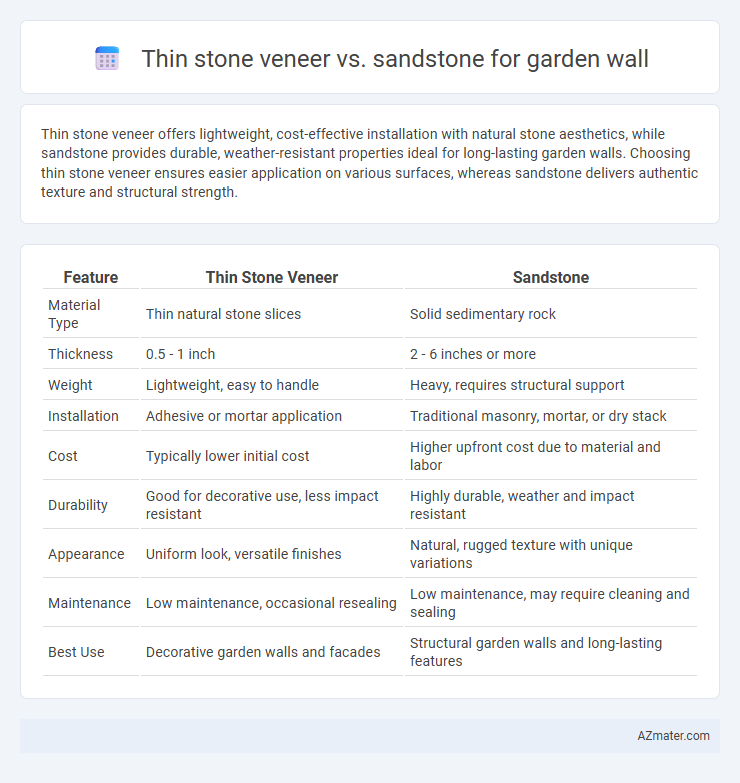Thin stone veneer offers lightweight, cost-effective installation with natural stone aesthetics, while sandstone provides durable, weather-resistant properties ideal for long-lasting garden walls. Choosing thin stone veneer ensures easier application on various surfaces, whereas sandstone delivers authentic texture and structural strength.
Table of Comparison
| Feature | Thin Stone Veneer | Sandstone |
|---|---|---|
| Material Type | Thin natural stone slices | Solid sedimentary rock |
| Thickness | 0.5 - 1 inch | 2 - 6 inches or more |
| Weight | Lightweight, easy to handle | Heavy, requires structural support |
| Installation | Adhesive or mortar application | Traditional masonry, mortar, or dry stack |
| Cost | Typically lower initial cost | Higher upfront cost due to material and labor |
| Durability | Good for decorative use, less impact resistant | Highly durable, weather and impact resistant |
| Appearance | Uniform look, versatile finishes | Natural, rugged texture with unique variations |
| Maintenance | Low maintenance, occasional resealing | Low maintenance, may require cleaning and sealing |
| Best Use | Decorative garden walls and facades | Structural garden walls and long-lasting features |
Introduction to Garden Wall Materials
Thin stone veneer offers a lightweight, cost-effective solution with easy installation and a natural stone appearance, making it ideal for decorative garden walls. Sandstone, known for its durability and natural weather resistance, provides a traditional, robust option that ages beautifully in outdoor settings. Choosing between thin stone veneer and sandstone depends on factors like budget, desired aesthetic, and long-term maintenance requirements for garden wall construction.
What is Thin Stone Veneer?
Thin stone veneer is a lightweight, natural stone layer typically ranging from 1/2 to 1 1/2 inches thick, designed to replicate the look of full-thickness stone without the heavy weight. It offers versatility, easy installation, and cost-effectiveness, making it ideal for garden walls where aesthetics and structural efficiency are important. Sandstone, a sedimentary rock known for its durability and warm tones, serves as a common material choice for both thin stone veneers and traditional thick stone, providing natural beauty and weather resistance to outdoor garden walls.
What is Sandstone?
Sandstone is a sedimentary rock composed mainly of sand-sized mineral particles or rock fragments, valued for its durability and natural aesthetic in garden walls. Thin stone veneer, often made from real sandstone, offers a lightweight, cost-effective alternative that provides the same rustic texture and color variations without the weight of full slabs. Choosing sandstone ensures weather resistance and a timeless appeal, making it ideal for exterior landscaping features.
Aesthetic Differences: Thin Stone Veneer vs Sandstone
Thin stone veneer offers a sleek, uniform appearance with consistent color and texture, ideal for modern garden walls seeking a refined, engineered look. Sandstone provides a natural, rustic aesthetic with unique grain patterns and earthy tones, creating a warm, organic ambiance. Garden walls with sandstone often display greater character through weathering and color variation compared to the controlled finish of thin stone veneer.
Durability and Weather Resistance
Thin stone veneer offers excellent durability and superior weather resistance due to its engineered composition and sealed surface, making it less prone to cracking and erosion in harsh climates. Sandstone, while aesthetically pleasing with natural texture and color variations, tends to be softer and more porous, which can lead to faster weathering and deterioration when exposed to prolonged moisture and freeze-thaw cycles. Choosing thin stone veneer for garden walls ensures longer-lasting structural integrity and minimal maintenance compared to traditional sandstone options.
Installation Techniques and Complexity
Thin stone veneer offers a lightweight installation process using adhesive or mortar directly onto prepared substrates, making it ideal for DIY garden wall projects with moderate skill levels. Sandstone, being heavier and thicker, typically requires traditional masonry techniques such as reinforced mortar beds and sometimes structural support, increasing both installation complexity and labor intensity. Selecting thin stone veneer reduces construction time and structural demands, whereas sandstone demands skilled labor and additional groundwork for stable, long-term garden wall installations.
Cost Comparison and Budget Considerations
Thin stone veneer offers a more cost-effective option compared to natural sandstone for garden walls, with prices typically ranging from $3 to $7 per square foot versus $10 to $20 per square foot for sandstone. Installation costs also favor thin stone veneer due to its lighter weight and easier handling, reducing labor expenses by up to 30%. Budget considerations should include not only material and installation costs but also long-term durability and maintenance expenses, where sandstone may incur higher upfront costs but offer greater longevity.
Maintenance Requirements and Longevity
Thin stone veneer requires minimal maintenance due to its lightweight nature and sealed surface, reducing susceptibility to moisture and staining. Sandstone, while naturally durable, demands regular sealing and cleaning to prevent erosion and moss growth in outdoor garden walls. Longevity for thin stone veneer typically ranges between 20 to 30 years with proper care, whereas sandstone can last 50+ years when maintained effectively in garden wall applications.
Environmental Impact and Sustainability
Thin stone veneer offers a lower environmental impact compared to traditional sandstone due to its reduced material usage and lighter weight, which decreases transportation emissions. Sandstone extraction often involves extensive quarrying, leading to habitat disruption and higher carbon footprints. Thin stone veneer's sustainable benefits include resource efficiency and easier installation, making it a greener choice for garden wall construction.
Choosing the Best Material for Your Garden Wall
Thin stone veneer offers a lightweight, cost-effective option for garden walls with easy installation and variety in texture and color, mimicking natural stone appearance. Sandstone provides durable, weather-resistant strength with unique natural grains and warm tones, ideal for long-lasting outdoor structures. When choosing the best material for your garden wall, consider factors like budget, maintenance, and desired aesthetic to balance practicality and visual appeal.

Infographic: Thin stone veneer vs Sandstone for Garden wall
 azmater.com
azmater.com